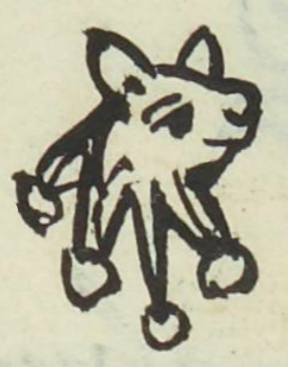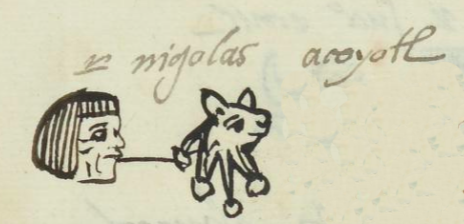Acoyotl (MH522v)
This black-line drawing of the compound glyph for the personal name Acoyotl ("Neotropic Cormorant," a waterfowl) shows four short streams of water (atl) with a droplet at the end of each one and lines of current in the streams. These jets of water come from the base of the head of a coyote (coyotl), shown in profile, looking toward the viewer's right. His ears are up, his one visible eye is open, and a nose and mouth are somewhat visible.
Stephanie Wood
The Water-Coyote is seemingly not meant literally, as there is a waterfowl called the acoyotl, which Eugene Hunn says is a Neotropic Cormorant. Thus, this compound is fully phonographic.
Stephanie Wood
nigolas acoyotl
Nicolás Acoyotl
Stephanie Wood
1560
pájaros, cormoranes, aves acuáticos, agua, coyotes, nombres de hombres

acoyo(tl), a waterfowl, the neotropic cormorant, https://nahuatl.wired-humanities.org/content/acoyotl
a(tl), water, https://nahuatl.wired-humanities.org/content/atl
coyo(tl), coyote, https://nahuatl.wired-humanities.org/content/coyotl
Cormorán (ave acuático)
Stephanie Wood
Matrícula de Huexotzinco, folio 522v, World Digital Library, https://www.loc.gov/resource/gdcwdl.wdl_15282/?sp=124&st=image.
This manuscript is hosted by the Library of Congress and the World Digital Library; used here with the Creative Commons, “Attribution-NonCommercial-ShareAlike 3.0 License” (CC-BY-NC-SAq 3.0).






